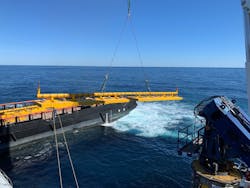NOIA: Low carbon intensity favors US deepwater production
A recent NOIA talking points memo has underscored the environmental favorability of deepwater production in the US Gulf of Mexico, with the region having a low carbon intensity compared with other producing regions.
The memo made the following points:
• Production from the Gulf of Mexico has a carbon intensity (kg/BOE) that is about one half of that of other onshore areas, especially when compared to the Permian basin.
• Deepwater oil on average has the lowest associated greenhouse gas emissions. If US offshore oil production is removed while leaving demand unchanged, total emissions increase.
• A November 2016 study from BOEM found that the outsourcing of GoM production to other countries would increase GHG emissions due to transportation-related emissions.
• Federal regulations require offshore operators to recover and sell all production, including gas and vapor. This means offshore production does not have routine venting and flaring, thus avoiding that source of emissions (30 CFR 250.1160).
Referring to the recent executive decisions on US OCS leasing, NOIA commented that: “Restricting or ending US offshore oil production will not address climate change. In fact, restricting US offshore oil production would lead to higher levels of greenhouse gas emissions. US production, and offshore production in particular, has a lower carbon footprint than other regions of the world that would take on oil production activities. Increased transportation of oil production to the US would lead to additional emissions.”
Murphy completes King’s Quay FPS transaction
Murphy Exploration & Production Company – USA has sold its 50% interest in the King’s Quay FPS and associated export lateral pipelines to a fund managed by ArcLight Capital Partners LLC.
The King’s Quay FPS and associated laterals will be co-owned in a joint venture with entities managed by Ridgewood Energy Corp., including ILX Holdings III, LLC.
This transaction reimburses Murphy’s past capex of about $270 million.
According to the company, the King’s Quay FPS is more than 90% built and is scheduled to go into service in mid-2022.
The King’s Quay FPS is designed to process 80,000 b/d of oil and 100 MMcf/d of gas, and will handle the anticipated production from the Khaleesi / Mormont and Samurai fields in the US Gulf of Mexico.
Oceaneering lands more work
Oceaneering International Inc.’s Subsea Robotics (SSR) and Offshore Projects Group (OPG) segments have received an integrated rig services contract for Murphy Oil Corp.’s Khaleesi/Mormont and Samurai fields in the US Gulf of Mexico.
The work scope includes the provision of ROVs with collocated ROV tooling and technicians, remote positioning and metrology survey resources, and installation and workover control system (IWOCS) equipment and technicians. Work is scheduled to begin in early 2021 and carry into 2022.
Earl Childress, senior vice president and chief commercial officer, said: “The operator’s decision to contract our robotics and IWOCS services is a positive and anticipated response to our realigned segments, which allows us to deliver the integrated processes and products that enable consistent and efficient work scopes.”
This award follows the recently awarded contract for Oceaneering’s Manufactured Products segment to supply 2-in. M5 connectors and chemical throttle valves for the Khaleesi/Mormont and Samurai tieback projects.
Sonardyne delivers remote operations service
Sonardyne has provided remote Fusion 2 survey operations capability on a live subsea construction campaign in the US Gulf of Mexico.
Using its new Remote Operations Access Module (ROAM), Sonardyne surveyors based in the UK were able to remotely access and operate the Fusion 2 survey and construction software onboard Subsea 7 vessels in the Gulf of Mexico.
By using the ROAM, potential limitations on operations posed by international travel restrictions were mitigated and the decision to upgrade from Fusion 1 to Fusion 2 was de-risked.
Fusion 2 is said to streamline offshore field development operations by reducing the time and capex needed to undertake survey and construction tasks. It combines traditional Long BaseLine (LBL) and inertial navigation system (INS) techniques in one. It can perform real-time simultaneous location and mapping (SLAM) calibration of sparse seabed transponder arrays. Real-time SLAM calibration capability means far less hardware has to be deployed on the seafloor, reducing vessel time, environmental, impact and equipment inventories.
ROAM is a rugged, portable communications link in a box which can operate over satellite or any other available network, such as 4G/5G and vessel Wi-Fi, providing secure access between Sonardyne engineers and any vessel needing remote expert assistance.
The remote operations service was provided last summer during a deepwater campaign on the Mad Dog Phase 2 project in the US Gulf of Mexico. Subsea 7 onboard surveyors were able to undertake remote training in Fusion 2 prior to deployment. Then, using the ROAM, Sonardyne surveyors working onshore in the UK were able to work shifts alongside their counterparts onboard the vessel in Fusion 2, supporting live positioning operations and taking secure control if required.
Edward Moller, Head of Energy at Sonardyne, said: “Facilitating remote operations is just one of the many steps we’re taking towards meeting industry’s and our own digitalization, environmental, and safety goals. While this is the first time we’ve provided a remote operational support for Fusion 2, it’s just the latest remote capability we routinely offer across our business, from data harvesting using uncrewed surface vessels to Ultra-Short BaseLine system verification tests on vessels of opportunity.”
About the Author
Bruce Beaubouef
Managing Editor
Bruce Beaubouef is Managing Editor for Offshore magazine. In that capacity, he plans and oversees content for the magazine; writes features on technologies and trends for the magazine; writes news updates for the website; creates and moderates topical webinars; and creates videos that focus on offshore oil and gas and renewable energies. Beaubouef has been in the oil and gas trade media for 25 years, starting out as Editor of Hart’s Pipeline Digest in 1998. From there, he went on to serve as Associate Editor for Pipe Line and Gas Industry for Gulf Publishing for four years before rejoining Hart Publications as Editor of PipeLine and Gas Technology in 2003. He joined Offshore magazine as Managing Editor in 2010, at that time owned by PennWell Corp. Beaubouef earned his Ph.D. at the University of Houston in 1997, and his dissertation was published in book form by Texas A&M University Press in September 2007 as The Strategic Petroleum Reserve: U.S. Energy Security and Oil Politics, 1975-2005.

